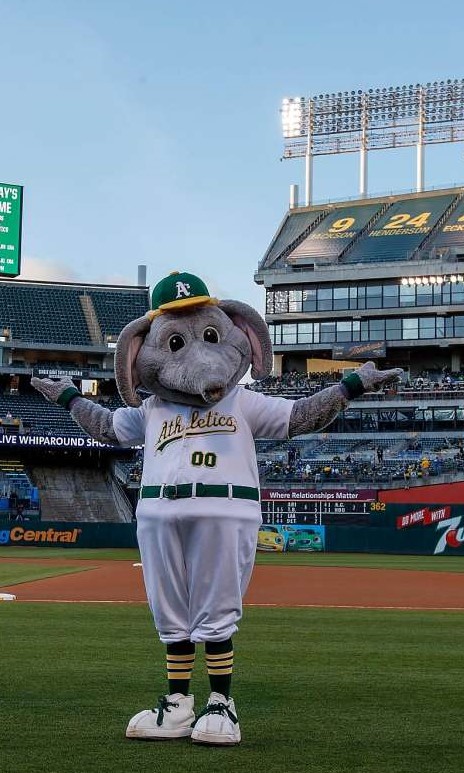For the last six decades, The Coliseum stands out as the most prominent sports venue in California’s Oakland. Opened in 1966 and renamed as RingCentral Coliseum in 2019, the massive ballpark exemplifies a multipurpose sports venue. It continues to host the MLB superteam Oakland Athletics ever since their relocation from Kansas City to Oakland. The baseball stadium is a living testimony to the Athletics’ three consecutive World Series dominance in the 1970s, prolific scoring during the 2000s, and recent post-season exploits.
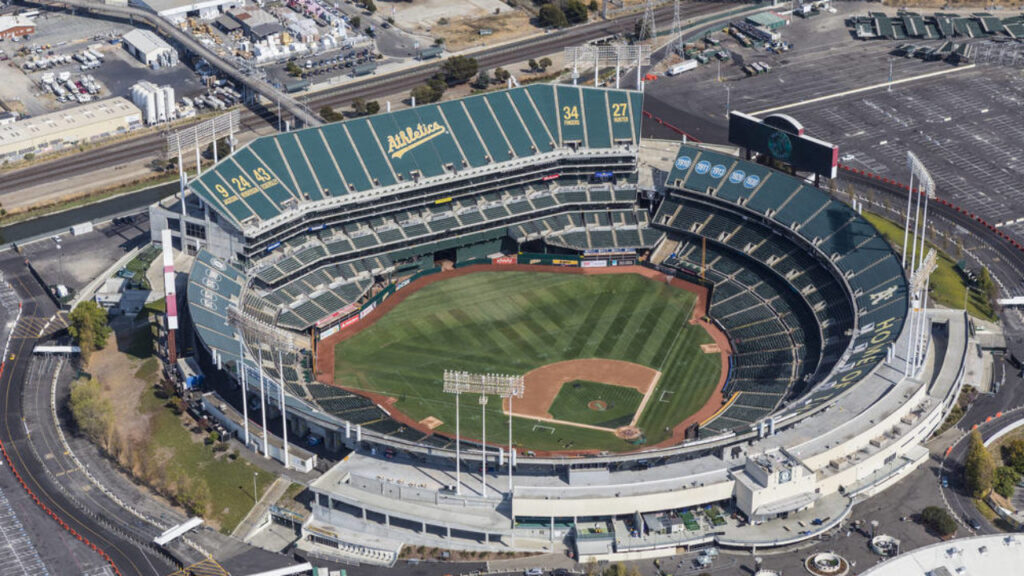
RingCentral Coliseum is the largest ballpark by capacity – 782 more than Dodgers Stadium when expanded. It is also the fifth oldest after Fenway Park, Wrigley Field, Dodgers Stadium, and Angel Stadium. The Coliseum is the first of only two multipurpose ballparks active in the Major Baseball League. Rogers Center, the other multipurpose baseball stadium, came into being 23 years later in 1989.
The History
RingCentral Coliseum was built as a multipurpose baseball stadium. While it continues to be the home of MLB franchise Oakland Athletics, the ballpark hosted the NFL team Oakland Raiders until 2019, when they moved to Los Vegas. Oakland Coliseum took shape out of the intense rivalry with neighboring San Francisco to host a major sports team. The local demand for a professional sports stadium in Oakland gained momentum in the 1950s.
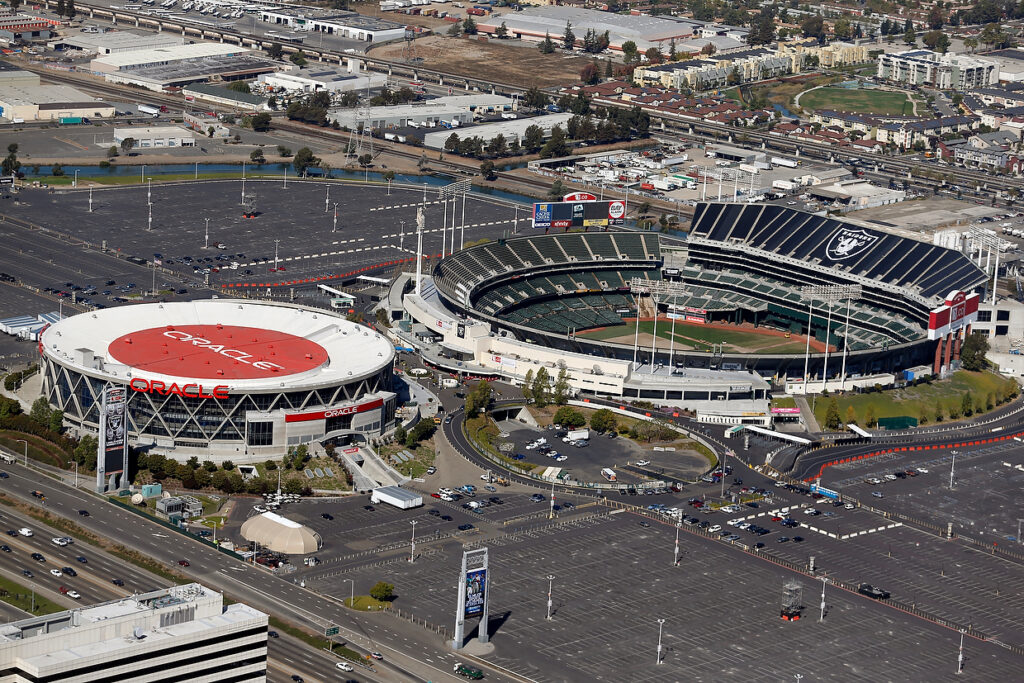
Real estate tycoon Robert Nahas formed a non-profit comprising Oakland business leaders to build a privately financed stadium. His Oakland–Alameda County Coliseum Board unveiled a design of the Oakland Coliseum and selected a site near the port in late 1960. The Oakland Raiders also joined the project next year. A $25-million funding plan with all necessary approvals was on the table in 1962 expecting an expansion of the MLB.
The construction of the Oakland Coliseum began in 1964 after overcoming legal hurdles. It was opened on September 18, 1966, with a football game between the Oakland Raiders played the Kansas City Chiefs. The temptation of a new baseball stadium enticed the Philadelphia Athletics, which was looking to relocate since 1961, to move to the Coliseum after the 1967 season. Thus, the new stadium became home to the Oakland Athletics in 1968.

Design and Features
A multipurpose, circular, open-air baseball stadium, RingCentral Coliseum boasts an underground design. The main concourse is above the first level and the field is 21 feet below sea level. Because of the deep playing level, an aerial view gives an impression of a small stadium. It has the unique credit of having the most foul territories among all MLB ballparks.
Until the Raiders played at the Coliseum, the stadium configuration used to change frequently to facilitate both baseball and football games. During the Athletics season, the orientation remained east-west but was converted to north-south once it ended. This often led to seat rows shifting places on and off the foul territory until 2019 when the Raiders left Oakland.
RingCentral Coliseum’s seating capacity varies between 34,000 and 63,132 – the lowest and the highest in MLB – based on the required configuration. If the “Mount Davis” deck is covered, it becomes the smallest MLB ballpark with 34,077 seats.
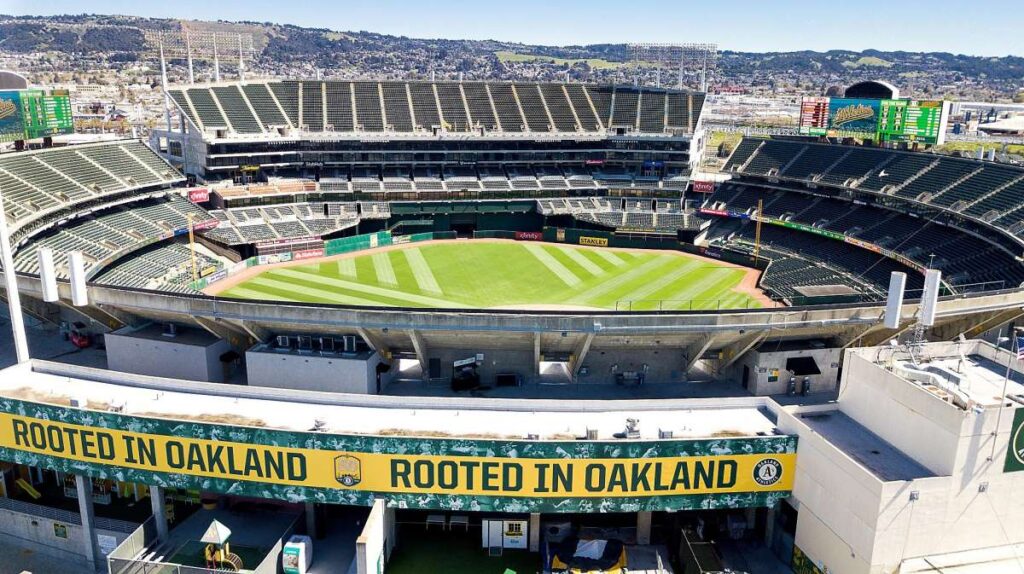
In 2005, the Oakland Athletics began planning a new 35,000-seat ballpark to replace the Coliseum. Even they contemplated a failed move to San Jose in 2015. However, the home team committed itself to the city and started planning to build a new stadium at the site of RingCentral Coliseum. In 2018, the A’s decided to construct a 34,000-seat stadium near the port and remodel Oakland Coliseum into a low-rise sports arena similar to Kezar Stadium in San Francisco.
Naming Rights
In the last five decades, RingCentral Coliseum went through several name changes.
- It was named Oakland–Alameda County Coliseum until 1998.
- In 1998, it became Network Associates Coliseum after the managed IT services provider bought naming right for $5.8 million.
- In 2004, the name changed to McAfee Coliseum following after Network Associates renamed itself to McAfee.
- Between 2008 and 2011, it became Oakland–Alameda County Coliseum again.
- In 2011, com bought naming rights in a six-year, $7.2-million deal making it Overstock.com Coliseum.
- From 2012 to 2016, it was known as O.co Coliseum in reference to Overstock.com’s promotional campaign.
- The old name Oakland–Alameda County Coliseum returned in 2016.
- In 2019, RingCentral bought the naming rights for a yearly payment of $1 million.
Facilities and Concessions
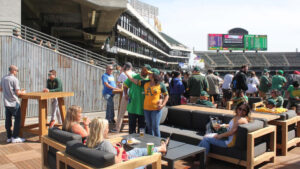
Fanatics, the official sports merchandise partner of the Athletics, runs two stores at Dennis Eckersley Gate and Catfish Hunter Gate of RingCentral Coliseum. These are open only on game days and accessible for fans holding game tickets. The collection includes a large assortment of sports gears and fan mementos.
The 10,000-square-feet Treehouse is the place to relax in RingCentral Coliseum. It offers a fun and joyous ambiance spread over a redwood patio deck with a lounge and bar, an interior sports bar, and a standing area. The Treehouse hosts TV and radio shows and DJ performances as part of its pre- and postgame entertainment.
The Stomping Ground provides a fun and interactive experience for kids visiting Oakland Coliseum. Shibe Park Tavern hosting food and beverage areas is a testimony to the Philadelphia days of the Athletics. It is built of bricks brought from Shibe Park, the home of Oakland A’s in Philadelphia.
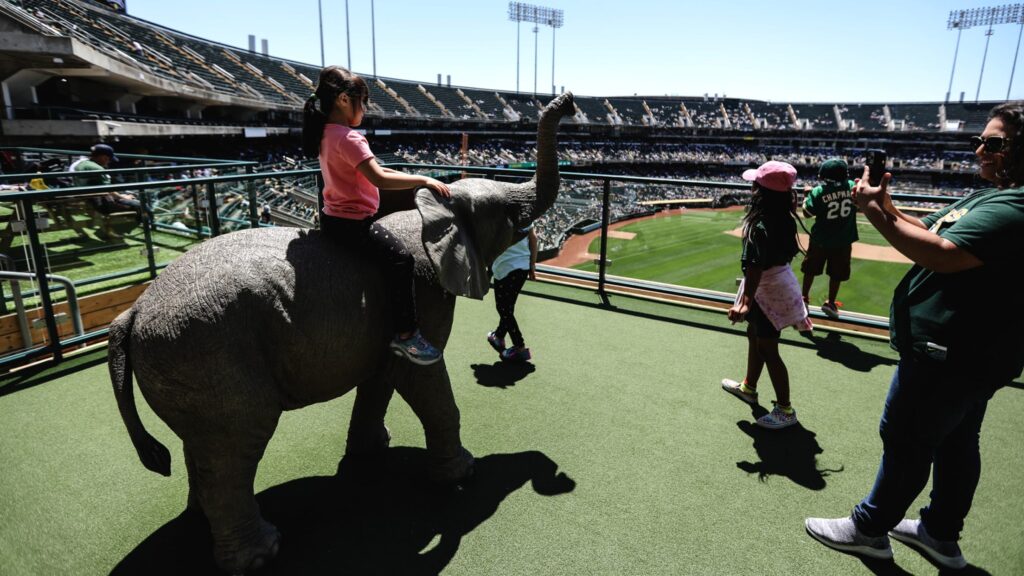
Purely Baseball Things To Know
- The Kansas City Athletics moved to Oakland in 1968 and started playing at the Coliseum.
- The Oakland Athletics won 1972 1973, 1974, and 1989 World Series, 1972, 1973, 1974, 1988, 1989, and 1990 AL Pennants, and 17 West Division titles since they moved to the ballpark.
- In their first game at the ballpark, the home team lost 1-4 to the Baltimore Orioles. However, they bounced back to register their first win the next day.
- Catfish Hunter pitched a perfect game blanking out the Minnesota Twins on May 8, 1968. Vida Blue repeated it against them on September 21, 1970. Mike Warren had it against the White Sox on September 29, 1983. Dallas Braden had another against the Tampa Bay Rays in 2010. Sean Manaea joined the league with a similar achievement against the Boston Red Sox in 2018. Mike Fiers had it in 2019 against the Reds.
- The Athletics played their first postseason game on October 5, 1971, and lost to the Orioles.
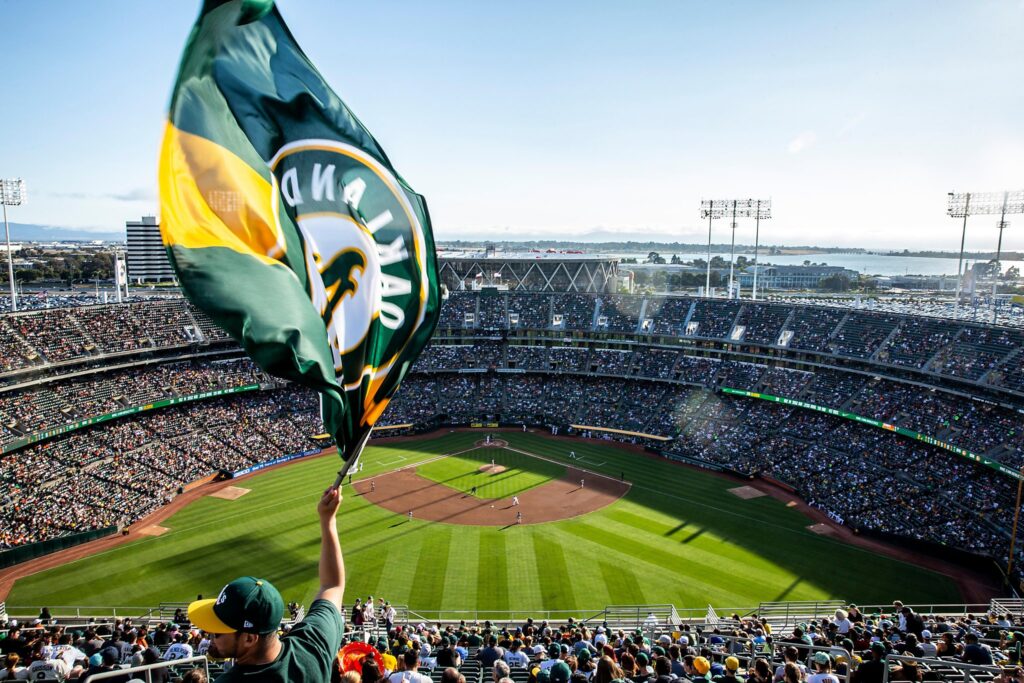
- October 5, 1971: First postseason game at The Coliseum. The A’s lose 5-3 to the Baltimore Orioles in the ALCS.
- While playing their first World Series game in 1972, the A’s narrowly survived a 1-0 scare against the Cincinnati Reds.
- In 1973, Texas Rangers’ pitcher Jim Bibby had a perfect game against the Athletics in a 6-0 win.
- The A’s won their first World Series title before the home crowd at RingCentral Coliseum beating the New York Mets on October 21, 1973.
- In 1974, they clinched the World Series title again at Oakland Coliseum routing the Los Angeles Dodgers 3-2.
- The Athletics secured a team no-hitter against the Angels on September 28, 1975. They repeated the feat against the White Sox in 1976.
- The home team made seven errors while playing the Royals in July 1976.
- The Oakland Athletics had their first and second triple plays at RingCentral Coliseum against the Kansas City Royals on June 19 and 23, 1979
- Oakland Coliseum hosted the 1987 All-Star Game.
- In 1989, Texas Rangers’ Nolan Ryan achieved his 5,000th strikeout while playing at the ballpark. The pitcher had another no-hit against the Athletics next year.
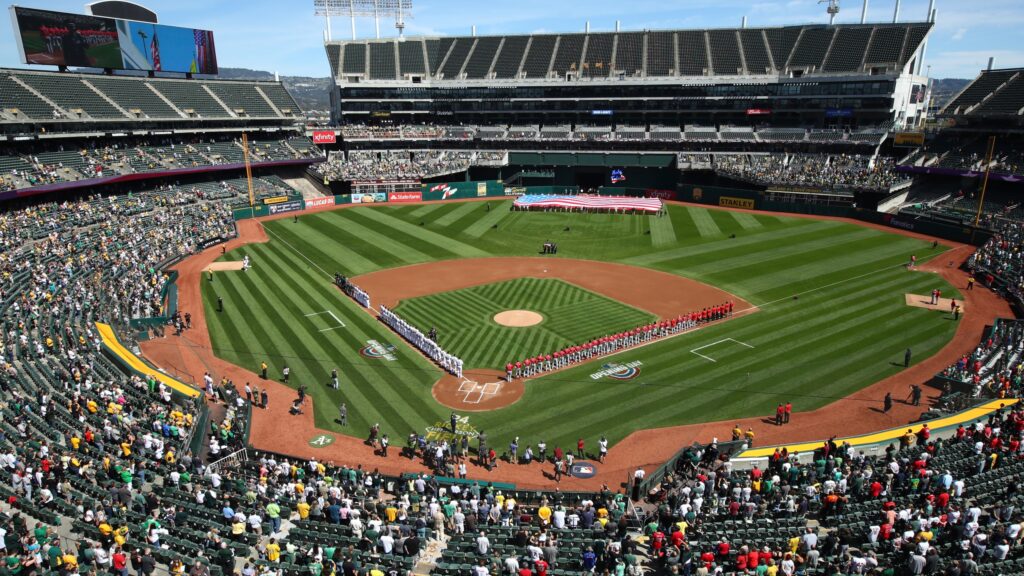
- On June 18, 1993, the home team bounced back from an 8-0 scare and defeated the Royals 10-9. Mike Bordick and Craig Paquette together hit five RBIs to win the game for the A’s.
- Of 5 cycles in the history of the Oakland Athletics, RingCentral Coliseum witnessed only one. Eric Chavez made it on June 21, 2000.
- Miguel Tejada hit a grand slam against the Rangers on September 30, 2000, before his home crowd. The Athletics won 23-2.
- An Athletics vs Astros game on August 15, 2019, witnessed 10 homers. The home team won it 7-6.



